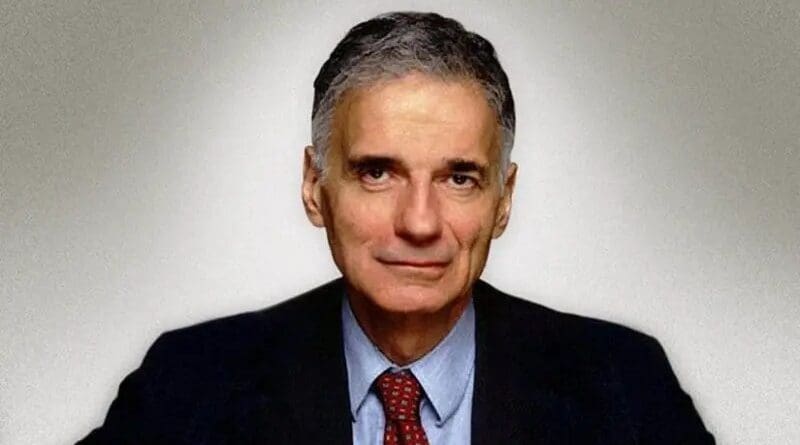Ralph Nader: Fed Guarantees Unproductive Debt And Perilous Speculation – OpEd
By Ralph Nader
The Federal Reserve Board – our unaccountable Central Bank – needs more citizen and Congressional supervision. Fees from financial institutions fund its operations, not Congressional appropriations. It is as secret as it wants to be and that’s plenty. (See Secrets of the Temple: How the Federal Reserve Runs the Country by William Greider). Plus, the Fed can print money at will. In the past several years it has “produced” trillions of dollars that juiced the stock market’s speculation.
Back nearly 90 years ago, the influential British economist, John Maynard Keynes, warned about stock markets veering into speculation and away from investments to build the real economy. Today, he might view stock markets as the epitome of wasteful “casino capitalism.” They have very little to do with raising money for useful investments and everything to do with making bets, as in multi-tiered derivatives, puts, and options to make money from money. Most often using, in Justice Louis Brandeis’s phrase, “other people’s money,” the Wall Street gamblers reap lucrative fees from unproductive speculation.
Fed Chairman, Jerome H. Powell, has chosen to instill “confidence” in the stock markets and credit markets by injecting trillions of dollars into the financial system to reassure the Wall Street speculators that the Covid-19 pandemic won’t crash the money markets into chaos and bankruptcies.
But Powell, the Fed and the bankers who dominate the Fed and its regional branches have set the stage for this constant bailout of reckless bubbles and debt binges. By keeping interest rates too low, now near zero, they have encouraged non-financial companies to go deeper and deeper into riskier debt ($6.8 trillion and surging). Borrowing has been so cheap that some of this debt was incurred by companies just to buy back their stock! Stock buybacks do not produce anything but higher metrics for executive compensation (See article, Why Stock Buybacks Are Dangerous for the Economy by William Lazonick).
Powell has turned a deaf ear to tens of millions of Americans, with modest incomes, who together have trillions of dollars in money market and bank savings accounts and are getting almost nothing by way of interest income. The result is less consumer spending. Yet Powell arrogantly says he’s not even thinking about raising interest rates even to one percent. Lenders like this approach because the sky-high interest rates they charge are not regulated.
Meanwhile, this huge pile of money looking for some return on investment is being lured into the stock market further driving up price-to-earnings (P/E) ratios into nosebleed territory.
Powell shrugs and assures the big boys on Wall Street that the Fed will have their back without limits. In return, the corporations continue their unproductive speculation and what the New York Times called a Fed-driven “debt binge.”
To make matters worse, these trillions of dollars are chasing fewer listed companies on the stock exchanges. Mergers, acquisitions, bankruptcies, and raising money from cheap debt instead of equity, over the past 25 years have cut the number of companies listed on the New York Stock Exchange by half.
Note how little all these financial machinations directly help the average families in America. More money is controlled by the few than ever before, but little is going into productive investments in the creation of jobs and services sorely needed in this, shaky “real economy”.
Some economists have written that “the stock markets are not the economy.” True enough if they are describing how stocks can soar on Wall Street while the Main Street economy plummets. Unfortunately, few economists focus on the stock market speculators sucking money belonging to the people (pension and mutual funds) into the speculation vortex while corporate bosses borrow cheap money, at record low-interest rates, for self-serving unproductive uses.
The Fed is pursuing a short-term game of guaranteeing corporations against self-imposed riskiness (the Fed is even starting to buy corporate bonds). This authoritarian Central Bank, with its own bulging red ink balance sheet, is turning its massive injections of “liquidity” into a narcotic for Big Business.
Such addictions hurt many innocent people back home trying to keep jobs, find jobs, and pay their bills. The House Democrats must hold rigorous public hearings on the Fed which ironically is demanding that Congress provide more immediate relief for ordinary people.
In May the House Democrats passed a $3 trillion package addressing these needs and sent the bill to a balking Republican-controlled Senate.
Now it is time for various House Committees to publicly question Chairman Powell about the costs of the Fed’s callous indifference to the real economy and struggling Americans.


Nader is right, The Fed has a long history of politically manipulating interest rates to favor Republicans in Presidential elections. The most egregious historical example is when the Fed increased interest rates up to 18% by election day to defeat Carter in 1980 and continue up to 21% by Reagan’s Inauguration Day January 1981. That way in the future Republicans could say “Do you want to go back to 21% interest rates under Democrats?” in subsequent elections.
Historically there has been a pattern to Fed policies that when Republicans held the Presidency, the Fed would raise rates in the first 2 years and lower them in the second 2 years to help re-elect Republicans. For Democrats the pattern was reversed. Lower rates in the first 2 years of a Democrat Administration and raise interest rates in the last two years to help defeat Democrats.